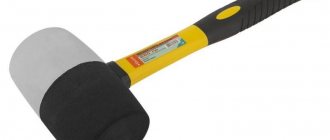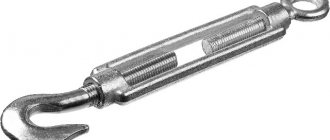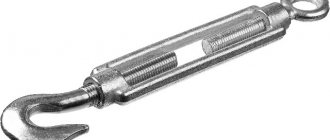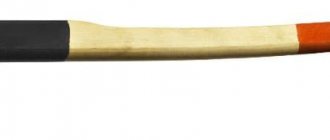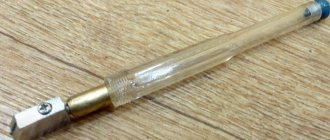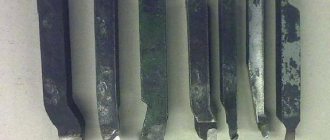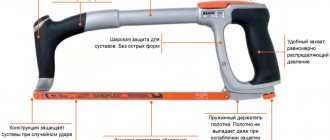For rough and fine processing of wood, a wide range of hand tools are used, some of which have an extremely simple design.
At the same time, they are indispensable in carpentry and carpentry. One of the most famous representatives of such a tool is the chisel.
Using a chisel, a sample is made in wooden products and the dimensions of the workpieces are adjusted.
However, the tool has become widespread outside the field of woodworking; its modifications are used in various industries and even in medicine.
In recent years, electric chisels have become increasingly popular, combining the functions of a woodworking machine and a hand tool.
But first things first.
Purpose of the chisel
When talking about chisels, we are usually talking about woodworking cutting tools.
Its versatility is expressed in a large number of jobs performed, including making recesses, cleaning grooves, chamfering, applying contour and relief carvings.
In addition, the tool is used for planing, and more specifically, for removing material of small thickness.
Sharpening chisels
In order for the sharpening angle to be wide and the “blade” itself to easily cut off the necessary pieces of wood, you need to sharpen the chisels in a timely manner. The procedure consists of three stages:
- First you need to use a coarse grinding stone.
- Then the turning process is duplicated on a medium-grained stone.
- The last stage is sharpening on a stone with a soft (velvety) coating.
It is advisable to carry out the sharpening process manually. This will help preserve the properties of the metal and will not thin the “blade”. A milling machine is relevant only in situations where it is necessary to remove defects from the cutting surface.
The ideal stone for sharpening would be a diamond one. Work on improving the canvas with the help of such a device can be done in 5-10 minutes. On a regular stone, the work will take about 20 minutes.
Before use, the stone must be treated with special oil or sprinkled with water.
Sharpening is done by performing translational movements back and forth. After passing the second stage, it is worth creating a microchamfer. You need to make 5 unilateral movements of the “blade”, which is located at an angle of 5 degrees relative to the whetstone.
It is enough to repeat this procedure 1-2 times a year. These woodworking tools dull slowly.
Device and characteristics
Structurally, a chisel is a metal sheet with a sharp blade located at the end.
On the reverse side there is a wedge-shaped shank, reminiscent of an ordinary nail, onto which the handle is driven.
In the classic version, the handle is made of wood, and a metal cap is installed at the point where it joins the blade.
Its purpose is to tighten the wood fibers and prevent the tool from breaking under pressure.
There are hand and impact chisels.
In the first case, cutting into the material is performed by hand pressure, and in the second case, by light blows with a mallet on the end of the chisel.
On the handles of impact mallets, in addition to the main cap on the back, there is a metal ring that acts as a headband and prevents cracking of the wood under impact loads.
Material
In the production of chisels, a durable but not brittle alloy is used.
All the requirements are fully met by tool steel grades KhVG, 9ХС and 9ХФ.
It is permissible to use steels with similar mechanical properties.
According to the method of manufacturing the canvas, they are distinguished:
- Stamped chisels.
- Forged - with increased blade thickness for processing materials with increased hardness.
- Punching – provide significant precision in processing products that have lower characteristics in terms of hardness and density.
As for the handles of chisels, in the classic version the material used for production is tough wood, for example, maple, ash, hornbeam, oak.
In addition, impact-resistant plastic or other material with similar characteristics is used.
In modern versions, the handle comes in:
- Two-component - it is based on impact-resistant plastic with rubber inserts for easy holding and to prevent hand slipping.
- Three-component. A combination of impact-resistant plastic at the ends with a softer appearance in the middle and rubber inserts or rubberized coating.
For percussion options, a metal butt plate is installed on the handle.
Dimensions and weight of the chisel
The standard length for chisels is considered to be 125 - 280 mm, where 110 - 145 mm falls on the blade, the width of which ranges from 4 - 50 mm.
Weight is 100 – 400 g.
GOST
Technical requirements and basic dimensions of flat and semicircular chisels are regulated by GOST 1184-80, which, in turn, contains references to GOST 14959-79, GOST 5950-73 and GOST 1435-75 (technical requirements for blade steel grades), as well as to GOST 2695-83 (regarding wood for handles).
Marking
Considering that tool steel is used in production, the marking on the product looks like the inscription “chrome vanadium”, CrV or drop forged.
In this case, a mandatory condition is the presence of a mark about the manufacturer, which is a kind of guarantor of quality.
On high-quality carving chisels, the steel grade is indicated directly on the blade using the electrographic method.
Attention!
Labels like “Hardened steel” should not be trusted.
Foreign manufacturers almost always indicate in the marking the elements present in the alloy, conventionally designated, for example, as W+Cr+V, or Cr+W, simply Cr or W.
The steel grade itself is also often indicated, for example, 86CrMoV7 or 62SiMnCr4.
Chisels for carving. Classification
A chisel is a professional tool for a carpenter or joiner, used to prepare wooden pieces for further processing. It will help to chamfer and apply carving patterns by removing excess layers of wood. The design of the chisel is very simple - it has a plastic or wooden handle and a sharpened blade of various shapes.
The following types of chisels exist:
- a straight chisel is needed for processing wooden blanks and cutting simple recesses
- an oblique chisel has a blade that is beveled at an angle of 450. It is used for cutting longitudinal grooves, as well as work related to the primary processing of the workpiece
- an angular chisel is similar to the English letter V, 2 closed planes of the blade are at different angles. It is necessary to create V-shaped notches. The sharper and shallower the angle of the cutter, the deeper the cutter will get
- A semicircular chisel for wood is perhaps the most important type of this tool. With this semicircular tool, the product is prepared, and ornaments of varying complexity are cut out and serifs are applied. The semicircular chisel can be round, medium or sloping
- cranberry is very similar to a semicircular chisel. The main difference is that its working surface is rounded not only along the end of the blade, but also along the shaft. This shape guarantees a clearer movement of the tool on wood. Cranberries are different. Their cutting part can be rounded, angular or straight
- Caesars can also be called a type of semicircular chisel, but they have a narrower working part, only 3 mm in width. Their main purpose is to cut thin grooves and work out the smallest details of the ornament.
- The gravers have a mushroom-shaped handle and an oblique cutter. They are mainly used for cutting grooves. With increasing pressure from the master, the carving becomes clearer and deeper
- A rivet is a mini-chisel for wood, which has a thin sharpening of a narrow blade, similar to a sharp leaf. This tool is used when ordinary chisels cannot create a drawing of the required accuracy.
- The marigold is also a type of mini chisel. It is designed for cutting thin fragments, however, more rounded than rivets
- the reverse chisel, like the cranberry, has a recess convex outward to create a protruding pattern above the plane of the main canvas.
Almost all of the listed chisels can have various modifications. A flat chisel can be wide or narrow, an angular chisel can have a wide angle or a narrow one, and a round chisel can have a flattened or radial bend.
Types of chisels and their prices
The names of chisels almost completely determine their features and the nature of the work for which they are intended.
This is how a chisel for working wood is:
- Manual - cutting into the material occurs from hand pressure on the handle.
- Impact - cutting into the material occurs by applying light blows with a mallet to the end of the handle, which has a metal butt plate.
A classic chisel has a shaft length of 150–170 mm, while a shortened one has a shaft length of 65–85 mm.
The following chisels are distinguished by purpose:
Carpentry
For fine and precise processing of workpieces, for example, a figured chisel, which allows you to carve hard and soft wood.
The latter include spruce, poplar, and linden.
Plotnitskaya
For rough, rough processing of workpieces of various types of wood.
Turning
For manual processing of parts rotating in a lathe, they are more often called turning tools.
According to the shape of the longitudinal section of the blade, the chisel can be:
Straight
The most common option is with a straight blade and blade, like a ruler.
Curved
With a longitudinal bend of the entire blade and blade.
Klukarza
With a sharp bend of the blade in the longitudinal direction, the beginning of which is located almost at the end of the straight blade. Used, for example, when cutting into door locks.
If the blade of the tool is sharpened on the reverse side, the corresponding classifier word is added to the name, for example, reverse cranberry.
By the way, reversible blades allow you to create convex parts of decorative relief.
According to the cross-sectional shape of the canvas, the chisel can be:
Flat
With a straight flat cross profile. It can be both wide and narrow, thick and thin (according to the parameters of the canvas).
The shape of the blade can be either oblique or straight. In the latter case, the cutting edge is perpendicular to the blade. Used for rough processing and creating straight lines.
Oblique
The previous version has a cutting edge that is beveled relative to the perpendicular to the blade.
This angle of attack makes it easier to cut into the wood base, increasing roughing speed.
Corner
The transverse profile is made in the shape of an angle (the letter “V”). The angle itself, as a rule, is between 60 and 90 degrees.
With such a tool you can make contour and relief carvings, and they can also be used to assign the contour of the future workpiece.
Radial
The cross section is made in the shape of a semicircle. Hence another name - semicircular chisel.
It is designed to perform accurate and smooth penetration into the material, which is probably why it is considered the most popular and in demand.
Such models are used for carving along a contour that has unevenness, where there are no sharp or right angles. The cutting part comes in two shapes: flat and sloping, and can also have a different radius of curvature.
Bracket (box-shaped)
The cutting edge is straight, with sides of different heights and different angles between these elements.
Suitable for even, narrow samples of material.
Cerasik
In structure it is close to the semicircular varinate, but has a significantly smaller thickness. This figured tool is used in artistic carving.
The cost of the types of tools described above is not too different from each other.
As a rule, the average price is 300 – 700 rubles per unit, and it depends, first of all, on the quality of the materials and the brand itself.
So there are models costing 1,300 rubles and more.
At the same time, the promotion of the manufacturer’s company affects pricing not in the least.
For comparison, a set of “Tatyanka” chisels for hand carving made of U10A steel (made by milling, 12 elements included) with a beech handle will cost about 10,000 rubles, that is, approximately 800 rubles each. a piece.
At the same time, Japanese ones are produced using a manufacturing technology different from traditional ones (two-layer steel with a hardness of 60 HRc), with a handle made of Japanese red oak.
For a similar set from Hattori (10 pieces) you will have to pay about 12 - 13 thousand rubles, which is already 1200 - 1300 rubles per piece.
However, the latter can be sharpened to razor sharpness.
Sets with more tools, of course, cost more.
In addition to tools for wood processing, there are options for work:
- For metal - an impact version of the tool with a specific sharpening configuration that allows you to process soft metals, for example, aluminum.
- For stone - a percussion tool, used for chipping material. A stone chisel is also suitable for giving the workpiece a fine faceted shape.
- For concrete - actually a chisel, but with a different configuration of the working part, including a semicircle. In most cases, it has a pobedite solder and acts as an attachment for a hammer drill.
Electric chisel
Along with the usual tool, they actively use its electrical modification, which is called an electric chisel, also known as a renovator.
The working element is a special attachment made in the form of already familiar chisels, which is selected depending on the type of work.
This universal machine is also called an electric chisel, multi-cutter or electric scraper.
The electric chisel has high performance and allows you to perform precise fine carvings.
The cost of such models is 5 – 9 thousand rubles.
In turn, it happens:
- Network - powered from a household network.
- Rechargeable – powered by a removable battery.
In addition to standard ones, there are also special chisels:
Surgical
The instrument used in medicine is made of surgical steel.
Vivid examples are the otolaryngological chisel for rhinoplasty and the Vojacek grooved chisel, which is used for trephination of the mastoid process using the hammerless method.
Pasichnaya
A tool for the daily work of a beekeeper.
A multifunctional chisel with a nail puller function and devices for lifting glued frames is called “European”.
Price – about 300 rubles.
For loops
A specially designed tool designed for knocking out rounded corners of seats for door hinges and locks after they have been milled. It is also called a corner chisel, but structurally it is very different from the tool of the same name described above.
The domestic modified version is the chisel of Pavel Soldatov, named, in fact, by the manufacturer.
The cost of the latter is around 3,400 rubles.
Plastic
For repairing car wheels, or more precisely, for cleaning protrusions, removing bumps and burrs from the tire.
An alternative name is a chisel-scraper.
Essentially an exact replica of a flat, straight instrument, but made entirely of plastic.
Price – about 200 rubles.
An option that resembles a multitool in design, however, without additional tools.
In fact, this is a folding chisel, where, when folded, the blade is located between the halves of the handle.
This allows you to safely transport and store the tool, for example in a pocket or bag.
Cost – from 600 rubles.
Mini chisel
A miniature version of a full-size tool, mainly used for fine carving on soft materials.
Beweiler (Beveller)
A flat-cut tool designed to thin leather at folds.
Alternative names are edge cutter or French chisel.
Cost – from 200 rubles.
Chisel-chisel
A percussion type of tool used to gouge out excess parts of material.
Chisel-jamb
Power sculpture knife (jamb knife) designed for relief geometric carving.
Each of the wood processing tools listed above has its own area of application, and therefore to create just one decorative relief you may need up to 10 different types of it, also of different sizes.
Main wood carving techniques
Different carving techniques require different positions of the device in relation to the wooden plane. There are three main ways to work on wood with a chisel:
- pruning This work is carried out on the growth of fibers; The tool is positioned with the unsharpened side of the blade facing up, and you need to hold the handle with one hand and the blade with the other so that your thumb is pointed at the handle. If you hold the chisel in this position, the master can easily set precise forces to obtain the most even and smooth surface possible
- side cutting or selecting grooves. Flat chisels are used to obtain rectangular grooves. The sharp edge can be beveled or straight. Most often, such a chisel is sharpened only on one side. Options with a semicircular sharp edge (in the form of a quarter or semicircle) of the canvas are used to create grooves in a circular manner
- perpendicular cutting. In this type of work, the chisel must be held by the handle with one hand, and the blade should be held with the thumb and forefinger of the other hand. In this way, you can thinly cut wood chips once. Note that this method is the most labor-intensive.
Read also: Copy device for wood lathe
Wood carving chisels are not designed to cut large amounts of wood at one time. Their task is to remove excess wood gradually, adhering to pre-defined lines.
You can use a mallet or hammer during the cutting process. These additional tools will be needed if you need to quickly make a recess or hole. At the same time, complex patterns require a lot of work and are cut out slowly.
Which chisel should you choose?
The following criteria will help you choose a good tool for your home:
- Blade. It must be hardened and free from rust, defects and deformations. Its thickness must correspond to the value specified by the manufacturer.
- Handle. It is better if the material is wood, since it is comfortable to hold in your hand without fear of slipping. An alternative is rubberized plastic options.
Avoid pure plastic without anti-slip inserts. If the handle is non-removable, there should not be even the slightest play. The presence of cracks on the surface will lead to rapid cracking of the material after several blows with a mallet. The best option is the classic conical or cylindrical shape of the handle. If you choose a chisel with a mushroom-shaped handle, you should keep in mind that it will not always be possible to work with it at sharp angles. - Price. A quality tool cannot be cheap. It is not necessary to buy professional chisel sets for home use, but they are more expensive and will last much longer.
You should not pay attention to unknown domestic and Chinese manufacturers.
Even if the steel can withstand severe mechanical loads, problems may arise with the handle, because... It is the most fragile part of the structure.
In addition, a high-quality blade of a branded tool will not have to be sharpened often.
The optimal length of the tool blade is 100-150 mm.
It matters how it was made.
Thus, cutting models provide high-level accuracy when processing materials with low hardness and density.
Stamped chisels require a thrust washer.
Otherwise, when struck with a mallet, the handle will “fit onto the shank” and will collapse over time.
NOTE:
There are two types of handle mounts: with a shank and with attached cones-skirts. The latter are a priority, as they are able to withstand heavy bending loads, torsion, as well as direct and lateral impacts, which plays an important role when performing various types of work.
Universal chisel
Just a few years ago, work with wood was carried out using hand tools, but today there are devices, for example, an electric chisel, that make it possible to significantly facilitate the work of the master, as well as increase the speed of work while maintaining high quality.
An electric chisel is called universal because it allows you to carry out a wide range of work. High-power chisel models can cope with the removal of old parquet boards or rough processing of a large piece of wood, removing knots and other hard inclusions. It is impossible to cope with such work using only hand tools.
This tool is considered universal because it has many attachments of different shapes and sizes. For example, small semicircular and straight 4 mm bits will help you make patterned carvings or engrave the master’s initials, while more massive tools, up to 5 cm wide, are designed for removing wide chips and roughing.
What you need to know about chisels?
A forged shank is always better.
The reason for this is that the hardness of the material is more evenly distributed throughout the chisel.
It can be determined by the characteristic flow lines of the metal.
Otherwise, the problem area becomes the transition zone of the shank to the blade, where stress concentration is observed, which will eventually lead to the formation of cracks.
